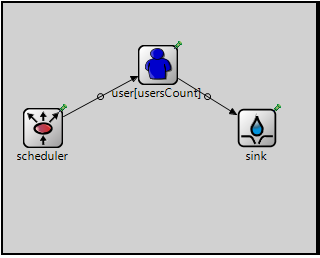The simulation model
The simulation model consists of the following OMNeT++ modules:
- A number of mobile users. In the first stages of the model you can
implement two identical users, then you can consider a number of
K users, organized as an array of users.
- A scheduler. The scheduler reads the lengths of users' queues and
implements a scheduling algorithm that allocates a number of radio
channels to each user. Then it informs each users how many radio blocks to
send during the current scheduling cycle.
You can consider that the total number of radio channels is B, for
example B=30 in LTE. The scheduler is activated every TB ms (a scheduling cycle). The value
of the scheduling cycle is 1 ms in LTE.
- A sink. The sink models the destination of the data. When the data
packets created
by an user arrive to the sink module, the sink simply deletes the OMNeT++
messages representing the data packets. Also, the sink is used to collect
statistics about the simulation, statistics that can be for each user and
for the entire system. This statistical information can be: the number
of data packets that arrive to the sink, the mean, minimum and maximum
delay of the data packets, etc.
A possible general model for the lte network is shown here:

A user consists of a source module (or generator) and a buffer module,
implemented as a queue. The generator generates a number of data packets
at certain time intervals. The data packets are stored in the buffer. When
the scheduler informs the user that it can send a number of, e.g. m
data packets, then the firsts m data packets from the buffer are
send to the destination (the sink module).
A possible general model for an user is shown here:

We can consider that all data packets have a fixed length.
In the OMNeT directories there is one called "samples", with different
simulation models implemented in OMNeT++. From these samples, you
can use as a starting point for your model the sources from the "fifo"
system.
Basic requirements:
Implement the simulation model described above using a fixed channel allocation
scheduling algorithm, e.g., each user receives a fix number of radio chanlles (of RBs).
More advanced requirements
- Implement other scheduling algorithms and compare their performance. For example,
implement the PF (proportional fair) channel dependent scheduling algorithm: you have to
model (randomly) the quality of the radio channel r[i] for each user i.
For each user it will be computed a parameter p[i], as a
product of its radio link quality r[i] and the time elapsed since it was
served last time.
The users will be served in the decreasing order of
their parameters p[i].
- Control the network load and represent graphically the mean delay of the data packets of
the users as a function of the network load, e.g. for network load of 30%, 50%, 70% and 90%.
- Compare the performance of the users (the mean delay here) when the users have different
weights W[i]. For example, you have two high priority (HP) users with W[i]=6 or 8, 5 medium
priority users (MP) with W[i]=2 and 3 low priority users (LP) with W[i]=1.
More information about scheduling algorithms can be found here

